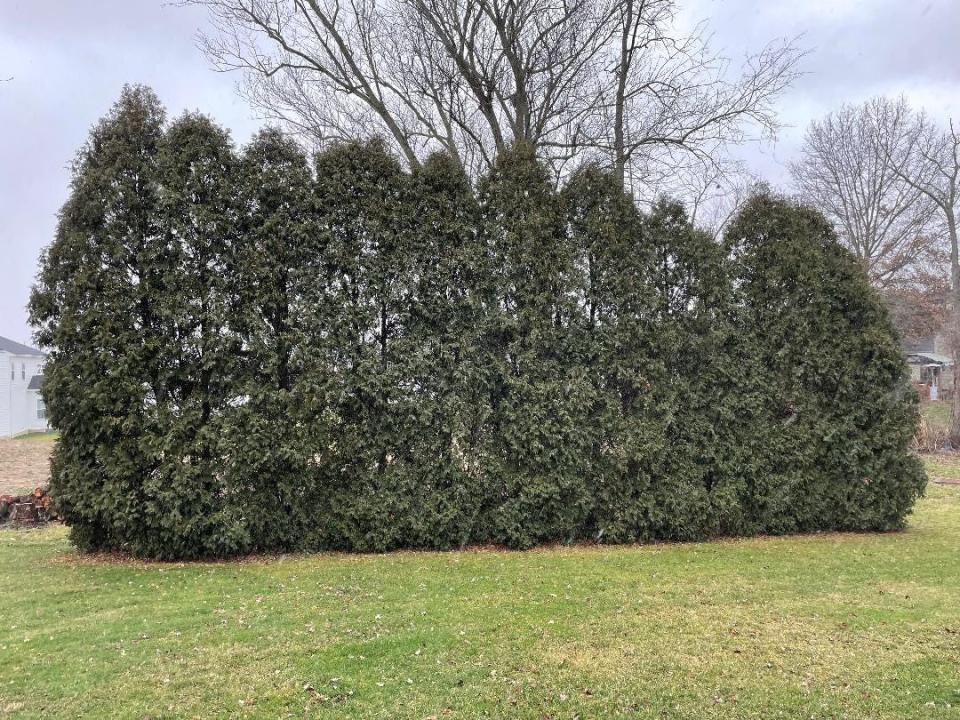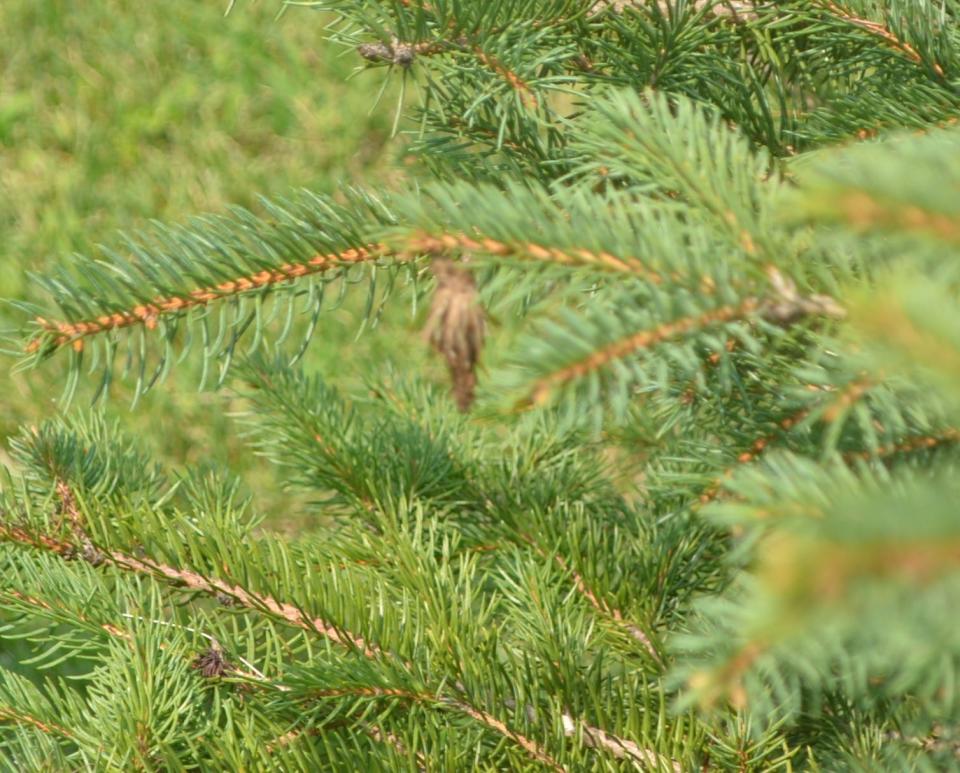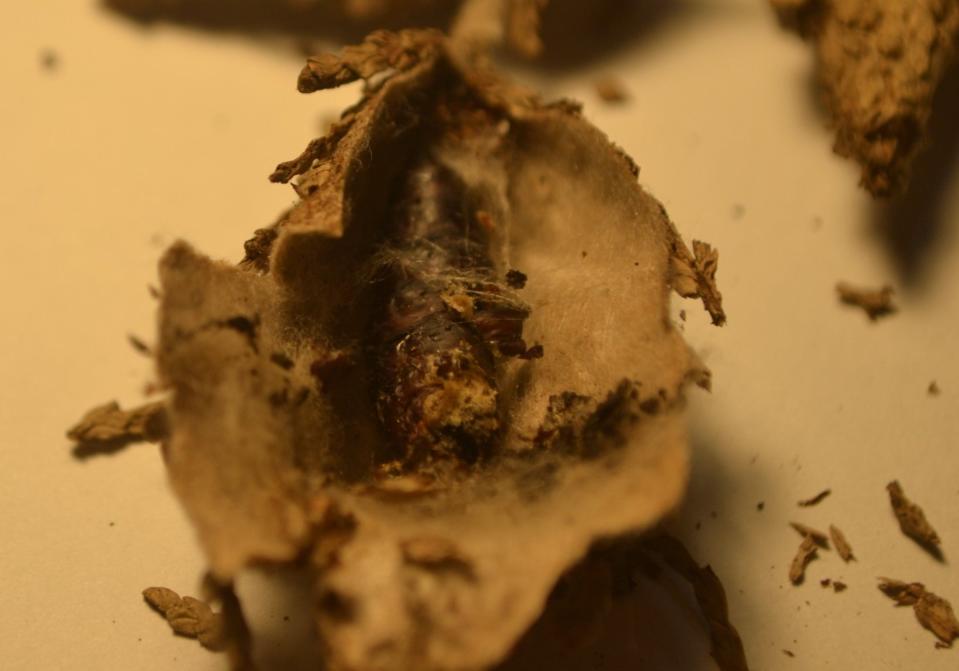A Stroll Through the Garden: Bagworm in an old stand of arborvitae
After I had just delivered a Christmas message at one of my churches in Canton, a friend I've know for 30 years was sitting across the table from me and asked about his old hedge of arborvitae. These huge trees have reached the point you can’t reach the top from the ground, and you can see what looks like little pinecones on his arbor vitae.
I said OK, I would like to see his trees. Well, it did not seem practical to go and visit so we settled for pictures. We talked for some time about the problem he had, and it seemed like bagworm and pictures could confirm the situation. It appears his tall evergreen trees have a pest that is common normally among arborvitae trees and 130 other plants.
When you first look at the cocoons, you may think you are looking at a small branch with a swelling problem or a pinecone. Initially, I would recommend you use a knockdown organic insecticide to remove as many as you can to start and spray as far as you can reach in the spring. You can always gather them by hand. I recommend picking as many of the moths as you can from the ground level then proceeding up the tree. The arborvitae I see in the pictures are not so infested with this insect, that this first step might go a long way in solving the problem.
Bagworm, or Thyridopteryx ephemeraeformis, is a clear-wing moth that spins its cocoon with bits and pieces of plant material that help the cocoon look like a branch on the tree. Each case grows from 1.5 – 2 inches. The caterpillars start out black and turn brown. Males look a lot like bees with black, furry bodies and clear wings. Females look like maggots with yellowish-white soft bodies, no mouth parts, no legs, no antennae, no eyes, tufts of hair near the end of the body, and stay inside the cocoon.
When fertilized she lays 1,000 eggs. Eggs are cream-colored and tiny. Ichneumonid wasps use this caterpillar to help hatch its babies that are laid on the caterpillar’s body. Woodpeckers, sapsuckers, hornets, and vespid wasps eat these insects for their meals. You can find the unusual relatives of Ichneumonid wasps in catalogues as predatory insect helpers. This clear-wing moth has a lot of natural predators.

Each bagworm here in Ohio will go through its life cycle in two years. The eggs and caterpillars share the cocoon. One good thing I can tell you about the bagworm’s life cycle is that you only have one set of eggs per year. Caterpillars start their work after they hatch and break their dormancy in late spring.
By removing this year’s cocoons, this insect will be managed effectively because it has a two-year life cycle of the insect and reusing the cocoons. By destroying most of the cocoons, you should be able to get rid of the insect for the most part.
Remember though that one female can lay 1,000 eggs. Winter cocoon removal can be effective in getting rid of insects for those you can reach and see, which is my first recommendation. The challenge is that cocoons can hide in the plant effectively and you will have a harder time reaching cocoons higher in the tree.

Pheromones can attract these moths and control them if you bring them with the idea of controlling them. A variety of insecticides can be used, but just after the eggs hatch and the caterpillar hatch. One of my favorite natural controls is Bt or Bacillus thurengensis or Dipel. Follow the directions for using this natural control and spray Dipel with the intent of spraying the plant. Sevin can also be used to control this moth if applied early in the season from late May to early July before they get large.
Permethrin or Eight, bifenthrin, and cyfluthrin can also be used to control this insect and should be also applied early in the season on the caterpillar, which may have challenges. Organic oils may also be used such as clove oil, cinnamon oil and others with success. As the females hatch from their cocoons, they have no mouth parts, which makes it difficult for the oil to enter their bodies. But with this oil sprayed over them, they may have a harder time surviving. Spinosad and Neem oil can also be used to control these insects at the correct time.
Spinosad is a broad-spectrum insecticide that may cause more damage than you may want. August applications of these chemicals become ineffective. Be careful if you spray to spray inside the trees because the canopies and leaves can be dense and prevent the spray from reaching the interior bagworms. I would also think a good coating of Tangle Foot 6 inches above ground level would control many of the caterpillars earlier in the year.
For a few years you need to make a practice of going over the trees once or twice during the year then you should feel confident in saying you have managed the insect.

Have a nice stroll in your garden this week both inside and outside. If you have some questions from things going on in your garden, do not hesitate in emailing me at ericlarson546@yahoo.com. I hope to be posting a blog written from this column on my website ohiohealthyfoodcooperative.org. Thank you for all of your questions.

Eric Larson of Jeromesville is a veteran landscaper and gardening enthusiast and a founding board member of the Ohio Chapter of Association of Professional Landscape Designers.
This article originally appeared on Mansfield News Journal: How to control bagworm in arborvitae

